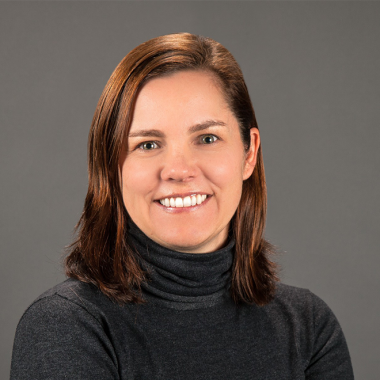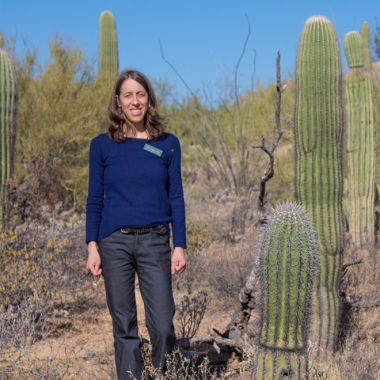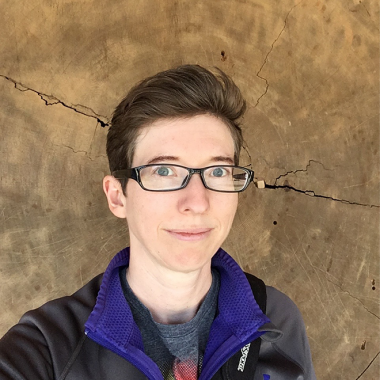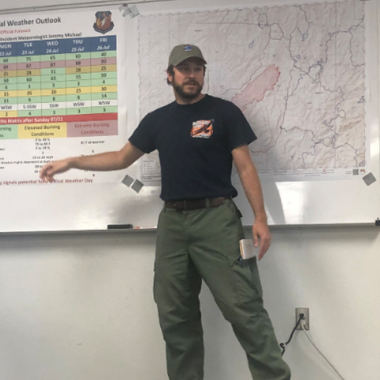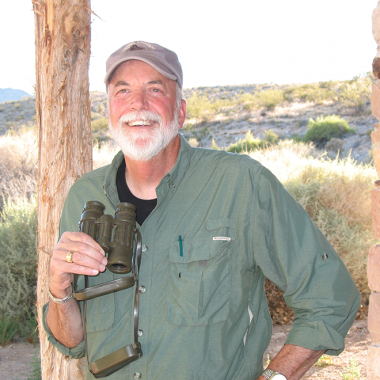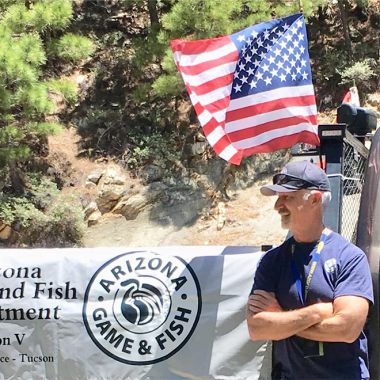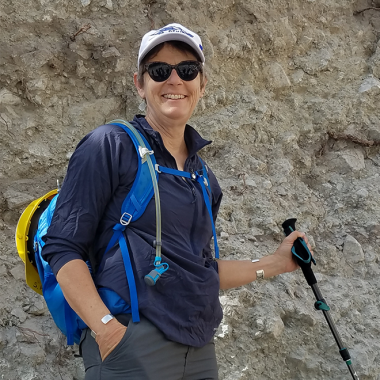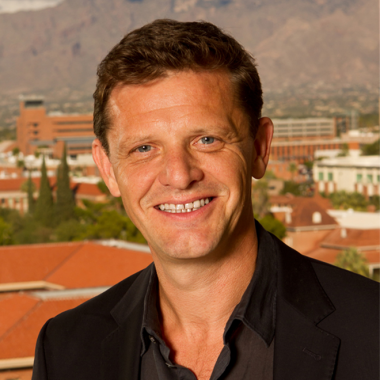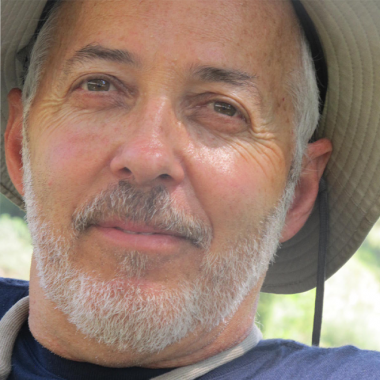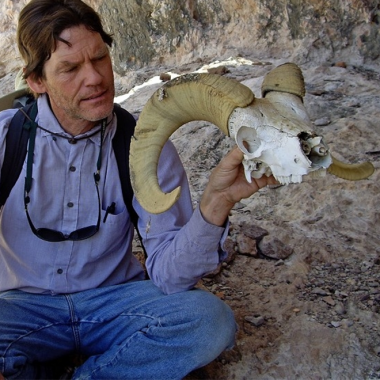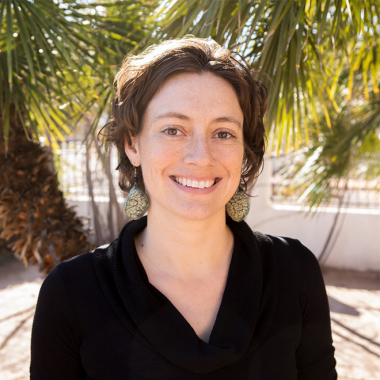Fire image used with permission by A.T. Willett, photographer (ATWillett.com | @atwillett)
A public engagement webinar series by the Arizona Institutes for Resilience: Solutions for the Environment and Society (AIR), premiered in August 2020
Over the weeks in June and July 2020, Tucsonans watched as a major fire swept across the Santa Catalina Mountains, a rolling inferno that seemed to engulf most of the range. On the evening of June 5th a dry lightning storm sparked the fire that proceeded to roar from Pusch Ridge in the west to Redington Pass in the east, forcing the evacuation of thousands of people who live on the top and along the mountain foothills.
We all have questions regarding what transpired and what the future holds. Why did this fire get so large? What was the role of climate change and drought? How was wildlife impacted, especially desert bighorn sheep? What role did invasive species have in the extent of the fire at lower elevations? This three-part public webinar series by the Arizona Institutes for Resilience brings the expertise of our community to address these questions and more through live interactions to help us better understand the fire on the mountain.
University of Arizona production partners: Desert Laboratory on Tumamoc Hill, Arizona Public Media, Center for Climate Adaptation Science and Solutions, Southwest Climate Adaptation Science Center
Want to get involved or learn more?
Check out our resources below for organizations working in restoration, adaptation and more.
Episode 1: The Event
Wednesday, August 5, 2020, 6 pm to 7:30 pm
Moderated by Tom McNamara, Arizona Public Media
The Bighorn Fire has covered over 120,000 acres of the Catalina Mountains, changing the landscape for decades to come. We will explore its genesis and behavior, and how a 1,000-person fire team responded to the blaze in a way that resulted in zero structures or human lives lost. Local researchers, fire professionals, ecologists, meteorologists, and geologists will help us understand the fire within the context of invasive species; previous burns and fire cycles of the Catalinas; and the weather conditions that fueled the fire, particularly through the lens of climate change. Collectively this session will allow us to see the fire in a new way and begin to comprehend the changes afoot.
Watch the episode
Meet the Panelists
USGS SW Climate Adaptation Science Center, Research Manager
Joint Fire Science Program, Science Adviser
School of Natural Resources & the Environment, Research Associate Professor
Molly is Associate Research Professor in the University of Arizona, School of Natural Resources and the Environment, an affiliation that began in July 2015. Her main duty is to serve as the primary science advisor for the Joint Fire Science Program, a role she has played since 2011. In addition, she serves as Research Manager for the Southwest Climate Science Adaptation Science Center and works as a Public Information Officer on wildfire incidents, including the Bighorn Fire. Prior to coming to the University of Arizona, Molly was an Associate Research Professor in the School of Forestry at Northern Arizona University, where she worked for eight years. While at NAU she taught a variety of continuing education courses for fire management professionals, maintained an active research program in fire ecology and management, and helped establish the Southwest Fire Science Consortium. Molly has a PhD in Forest Science from Colorado State University and a BS in Plant Biology from the University of California at Davis.
Conservation Science Manager for the Arizona-Sonora Desert Museum
Dr. Kimberly Franklin is Conservation Science Manager for the Arizona-Sonora Desert Museum. She leads the Desert Museum's Save our Saguaros campaign to control buffelgrass, a highly flammable grass native to Africa that now threatens our Sonoran Desert ecosystem. An insect biologist by training, Kim obtained a Fulbright Scholarship to study the effects of buffelgrass on insect diversity in Sonora, Mexico for her doctoral research at the University of Arizona from 2003-2009. She has continued to study insect diversity in the Sonoran Desert as a postdoctoral fellow at the University of Arizona's Center for Insect Science from 2009-2011 and as a Research Scientist at the Arizona- Sonora Desert Museum since 2011.
Postdoctoral researcher, University of Arizona
Laura A. Marshall, PhD, from the University of Arizona School of Natural Resources and the Environment and the Laboratory of Tree-Ring Research is beginning her career in forest ecology and resilience, with an interest in the intersection of past disturbance and climate as a driver of community change. She is currently working on vegetation type conversion in southwestern US forests, and pursuing an additional graduate certificate in geographic information science. She is often found running trails in the mountains around Tucson—when the forest is open.
Catalina District Ranger, U.S. Forest Service, Coronado National Forest
Fire and Aviation Staff Officer for the Coronado National Forest
National Weather Service, Tucson
Jeremy Michael is a meteorologist for the National Weather Service (NWS) in Tucson, AZ. Before arriving in Tucson, he grew up in Berkeley Springs, WV. He attended the University of North Carolina-Asheville, where he completed an Atmospheric Science Degree. The love for mountain meteorology, fire weather, and adventure drove him west to Elko, Nevada. After a couple great years, he headed back east to College Park, MD, to work for the Satellite Analysis Branch within NESDIS. After gaining a year of valuable experience with satellite forecasting, he went back to work for the NWS in Elko, NV, for another two years, before finally landing in Tucson. Over the past three years, he was able to gain certification as an Incident Meteorologist and Air Resource Advisor. He has supported a number of fires in Nevada, Arizona, Utah, Oregon, California, and New Mexico. In his free time he enjoys hiking, rockhounding, and working on his new backyard tending to desert plants.
Episode 2: The Aftermath
Wednesday, August 12, 2020, 6 pm to 7:15 pm
Moderated by Tom McNamara, Arizona Public Media
There is no doubt the Bighorn Fire will have an enormous impact on most aspects of the Catalina Mountains. But to what extent? How might it affect the mountain's wildlife, including desert bighorns, and plant life? What can we expect when the rains arrive with so much less vegetation upslope? Our experts will share research and insights into how this and other fires affect sky island species and physical factors in near time, and what we can expect to see in the coming weeks and months.
Watch the episode
Meet the Panelists
Profession emeritus, University of Arizona School of Natural Resources and The Environment
Dr. Paul R. Krausman was the third Boone and Crockett Professor at the University of Montana (2007-2015) following 29 years as Professor of Wildlife Conservation and Management at the University of Arizona and two years as an Assistant Professor at Auburn University, Alabama. He is currently Professor Emeritus at the University of Arizona and lives in Santa Fe, New Mexico. Dr. Krausman holds degrees from The Ohio State University (B.S., Zoology), New Mexico State University (M.S., Wildlife Management), the University of Idaho (Ph.D.,1976), and was awarded the Leopold Medal from The Wildlife Society in 2006. He has received other awards for his work with mule deer (O.C. Wallmo Award,1999), mountain sheep (Desert Ram Award, 2000), and publications among others. Dr. Krausman has numerous publications and has been the editor of the Desert Bighorn Council Transactions, The Journal of Wildlife Management, and Wildlife Monographs, and has been an associate editor for 5 other journals. He is the current Editor-in-Chief of the Journal of Wildlife Management and Wildlife Monographs. Dr. Krausman has taught an array of wildlife-related classes throughout his career including Scientific Writing for Publication, Big Game Ecology, Applied Wildlife Management, and other wildlife related classes. He has directed nearly 100 graduate students on ungulate and predator studies throughout the United States and in India. The most rewarding aspect of his career is the development of the future leaders of the wildlife profession—students.
Arizona Game and Fish Department
Mark Hart is a public information officer with the Arizona Game and Fish Department in Tucson. He serves as department spokesman for southeastern Arizona news media, and manages information and education programs throughout the region. Hart joined the department in 2009, and also serves as a public information officer for the Arizona Department of Forestry and Fire Management. In addition, he is an agency representative to the federal Borderlands Management Task Force. Hart, an alumnus of the American Wilderness Leadership School in Jackson, WY, earned a bachelor’s degree with high honors from Loyola University of Chicago in 1981.
Arizona Geological Survey
Ann Youberg is a Senior Research Scientist at the Arizona Geological Survey in the University of Arizona. Ann has over 30 years of experience in geological, geotechnical and geomorphic investigations and has been with the Environmental Division of the AZGS for over 20 years. Ann’s work at the AZGS includes surficial geologic, geomorphic and geologic hazards mapping, but her main focus is on post-wildfire hazard assessments and research. Current and recent research projects include identifying rainfall intensity-duration thresholds that trigger post-fire debris flows in Arizona and New Mexico, identifying the impacts of successive wildfires on post-fire runoff and erosion, developing a post-fire debris-flow inundation model for AZ and NM, and developing a method to identify areas at risk from post-fire flooding and debris flows before a wildfire occurs in an effort to mitigate and reduce those risks.
Professor of Hydrology and Atmospheric Sciences, and Director of Research, Biosphere 2
Dr. Peter A. Troch studied Agricultural Engineering at the University of Ghent, Belgium, and graduated with Highest Distinction. He holds a MSc degree in Systems Control Engineering and he obtained his Ph.D. degree in Hydrology in 1993 at the same university. Dr. Peter A. Troch is since November 2005 Professor of Surface Water Hydrology at the Department of Hydrology and Atmospheric Science of The University of Arizona. His current research involves hillslope to catchment scale hydrological processes, seasonal, decadal and climate predictions of water availability in semi-arid river basins, as well as developing research infrastructure to investigate Critical Zone processes across climate gradients. He is also studying the role of vegetation in catchment-scale hydrological response. He is Science Director of Biosphere 2, and editor of Water Resources Research. He has published over 180 papers in refereed international journals dealing with (flash) flood forecasting, catchment classification and similarity, landslide and debris flow modeling, remote sensing applications in hydrology and data assimilation, climate variability and climate change impacts on water availability, and the role of vegetation on hydrologic partitioning at catchment scales. He is the recipient of the 2011 John Dalton Medal, awarded by the European Geophysical Union for distinguished research in hydrology evaluated as an earth science, and the 2011 Boussinesq Lecturer at the Netherlands Royal Academy of Sciences, Amsterdam. He is AGU Fellow since 2015 and Agnese Nelms Haury Chair in Environment and Social Justice.
Director, National Phenology Network
Theresa has been a part of the USA National Phenology Network organization since 2007. Hailing from Ohio and Michigan, she received a B.S. and M.A at Western Michigan University and a Ph.D. from the University of Arizona. In her role with the Network, Theresa supports an amazing team of individuals and works enthusiastically to support the growth and use of phenology data and resources curated by the USA-NPN, involvement in Nature’s Notebook, and a broader appreciation of phenology among scientists and non-scientists alike.
Theresa also maintains an active research career and has published over 60 peer-reviewed articles and book chapters in journals including Geophysical Research Letters, Global Change Biology, PLoS ONE, and Journal of Ecology. Her writing has also appeared in Scientific American and the Arizona Daily Star, and she has appeared in the PBS productions SciGirls and American Spring Live as well as on NPR and The Weather Channel. She currently serves on the editorial board for Ecosphere. In 2018, Theresa received the Alumni Achievement Award from the Department of Geography as well as the Globally-Engaged Pillar Award from the College of Arts and Sciences at Western Michigan University.
Episode 3: The Future Catalinas
Wednesday, August 19, 2020, 6 pm to 7:15 pm
Moderated by Vanessa Barchfield, Arizona Public Media
Nature—of which humans are a part—is incredibly resilient. How will the ecological processes and species of the Catalinas rebound (or not) from the effects of the Bighorn Fire? What are the projections for restoration? The researchers in this session have been studying long-term effects of fire in the Sky Islands for decades. They will share insights gained from this careful study that allows us to look into the future and find solutions to restore the landscape and mitigate the challenges ahead. Future actions are broad and we will focus on how you can get involved with local organizations in monitoring and restoration efforts.
Watch the episode
Meet the Panelists
Professor, School of Natural Resources and the Environment, University of Arizona
Professor, Dendrochronology, Laboratory of Tree-Ring Research
Professor, Global Change, Graduate Interdisciplinary Degree Program in Global Change
Affiliated Faculty, Arizona Institutes for Resilience
Don Falk’s research focuses on fire history, fire ecology, and the adaptation of restoration ecology to resilience in a changing world. He is a Fellow of the American Association for the Advancement of Science (AAAS), and has received a Fulbright Short-Term Scholar award, the Ecological Society of America’s Deevey Award, and the Udall Faculty Fellowship in Public Policy. He is the author of more than 150 publications, including five edited books: Genetics and Conservation of Rare Plants, Foundations of Restoration Ecology (now in Second Edition) and The Landscape Ecology of Fire. Don was a delegate to the 2015 UN climate summit in Paris and leads the University of Arizona’s undergraduate degree program in Global Change Ecology and Management. Don holds degrees from Oberlin College, Tufts University, and the University of Arizona. Don was co-founder and Executive Director of the Center for Plant Conservation, originally at Arnold Arboretum of Harvard University and now at San Diego Zoo Global; he then served as the first Executive Director of the Society for Ecological Restoration.
Research Scientist, University of Arizona School of Natural Resources and the Environment
Jim Malusa got his first backpack on his 16th birthday, and immediately set off into the Catalina Mts. Forty-seven years later, he’s seen a lot of changes. Equipped with a camera, map, several cans of refried beans, and a PhD from the University of Arizona’s Dept. of Ecology and Evolutionary Biology, Malusa has hiked and documented vegetation throughout the Coronado National Forest. The botanical diversity is mind-boggling because the Coronado sits at a four-way intersection, where the Sonoran Desert meets the Chihuahuan, where the tail of the Rocky Mountains becomes the tip of the Sierra Madre. Ten years ago he took a series of photos in the Chiricahua Mountains for a vegetation map. A year later, the mountain burned. Malusa’s been returning every two years to the same locations to document the trajectory of vegetation change, and today he’s going to share some of those photo sequences to give us an idea of the resilience of different vegetation types, from saguaros to pine trees.
Executive Director, Sky Island Alliance
Louise worked with Sky Island Alliance for the past nine years, most recently as Conservation Director. She was the principal architect of a regional climate change adaptation workshop series designed for resource managers to advance understanding of impacts on ecosystems and wildlife. This led directly to critical new work to survey, protect and restore fragile spring ecosystems. In 2015, she conducted sabbatical work in Australia, where she met with natural resource colleagues to share methodologies for assessing vulnerability of biodiversity, water sources, and human communities to climate change, and developing responsive science, policy and adaptation strategies. She is committed to crafting creative solutions to pressing conservation issues and building collaboration among diverse partners. She holds a B.A. in Ecology and Evolutionary Biology, a B.S. in Microbiology, and an M.S. in Geographic Information Systems, all from the University of Arizona. She is currently Vice Chair of the Desert Landscape Conservation Cooperative, and a member of the Community Water Coalition Advisory Committee, the Art and Environment Network Executive Committee and the Wildlife Conservation Society Climate Change Adaptation Fund Advisory Committee.
Director, Desert Laboratory on Tumamoc Hill
Ben's research is broadly focused in desert ecology and botany. He utilizes multiple approaches and time scales to establish baselines to better understand modern biodiversity and connect science to conservation.
Ben received his PhD in 2014 from the University of California, Riverside under the guidance of Dr. Exequiel Ezcurra for his dissertation research, "Historical Biogeography of the Midriff Islands, Gulf of California." From 2014–2015 he was a Visiting Scholar in the lab of Dr. Rodolfo Dirzo at Stanford University focusing on ecological education for indigenous communities.
His work increasingly looks at the incorporation of diverse perspectives and the powerful results made possible via collaboration. In his role as director of the Next Generation Sonoran Desert Researchers (N-Gen) he strives to create opportunities for collaboration across borders and disciplines and a more holistic understanding and appreciation for the Sonoran Desert.
Since October 2016 Ben has been director of the Desert Laboratory on Tumamoc Hill. He also works with Dr. Christopher Scott in the administration of CAZMEX, the Consortium for Arizona-Mexico Arid Environments.
- Arizona-Sonora Desert Museum’s Save Our Saguaros Project
- USA National Phenology Network's Nature's Notebook Program
- Sky Island Alliance — restoration and wildlife monitoring
- Watershed Management Group — restoration and monitoring
- Desert Bighorn Sheep Society — game surveys and conservation, including Catalinas restoration
- Arizona Game & Fish Department — bighorn sheep surveys
- Coronado National Forest, Catalinas District — volunteer opportunities
- Critical Zone National Observatory — Catalinas
- Biosphere2 — take a tour
University of Arizona
- Center for Climate Adaptation Science and Solutions (CCASS) — climate adaptation
- Climate Assessment for the Southwest (CLIMAS) — climate adaptation
- Southwest Climate Adaptation Science Center (SW CASC)
- Bridging Biodiversity and Conservation Science (BBCS) — emerging transitions needed to mitigate and adapt to climate change
- Institute for Energy Solutions (IES)
- University Climate Change Coalition (UC3)
- Office of Sustainability
City and County
- City of Tucson’s climate change, sustainability and resilience policies
- Pima County Sustainability Programs Division Sustainable Action Plan for County Operations (2018-2025)
Community
- Tucson Climate Action Network (and they're on Facebook!)
Arizona Illustrated hosted a 30-minute Bighorn Fire special in November 2020, produced by Vanessa Barchfield, including:
- Lessons from the Chiricahuas: What happens to ecosystems after a wildfire or other major disturbances?
- After the Burn: In the aftermath of the Bighorn Fire, researchers see a unique opportunity to better understand how fire impacts southern Arizona's delicate sky island ecosystems.
- Wildlife and the Bighorn: A look at some of the specific wildlife species that live in the Catalina Mountains north of Tucson and how wildfire impacts their existence.
Fire on the Mountain Producers and Staff
Executive Producers
Benjamin Wilder (Director, Desert Laboratory on Tumamoc Hill)
Roseann Hanson (Art and Science Program Coordinator, Desert Laboratory on Tumamoc Hill)
Sarah Smallhouse
Moderators
Tom McNamara (Arizona Public Media)
Vanessa Barchfield (Arizona Public Media)
Technical Facilitators
Maya Patterson (Arizona Institutes for Resilience: Solutions for the Environment and Society)
Anna Seiferle-Valencia (Program Coordinator, Desert Laboratory on Tumamoc Hill)
Amanda Leinberger (Adaptation Program Manager, Center for Climate Adaptation Science and Solutions)
Producers and Advisors
Gregg Garfin (Deputy Director for Science Translation and Outreach, Arizona Institutes for Resilience; School of Natural Resources and the Environment and University Director, Southwest Climate Adaptation Science Center)
Betsy Woodhouse (Program Manager, Earth Dynamics Observatory)
Kathy Jacobs (Director, Center for Climate Adaptation Science and Solutions)
Don Falk (School of Natural Resources and the Environment)
John Booth (Arizona Public Media)



